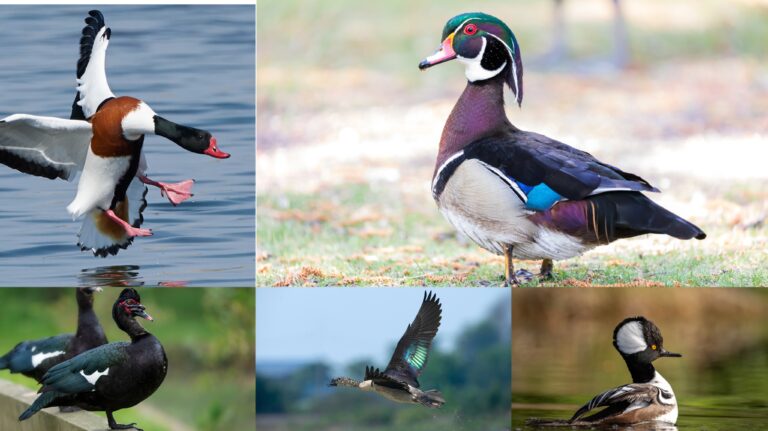8 Most Beautiful Eagles in the World
Eagles are symbols of strength, beauty, and freedom. This majestic bird of prey has sharp eyes and powerful claws, is awe-inspiring, and plays a critical role in their ecosystems. In this article, we’ll explore 8 of the most beautiful eagles worldwide, highlighting what makes each unique and worth admiring with their sharp eyes, powerful claws, and impressive wingspans.
These majestic birds of prey are found in diverse habitats across the globe, each species showcasing unique traits, plumage, and survival tactics. From the iconic Bald Eagle of North America to the rare Philippine Eagle, let’s soar through the skies and meet the seven most beautiful eagles in the world. This list explores the characteristics that make each of these birds stunning and awe-inspiring.
1. Harpy Eagle: The Forest Giant of Central and South America
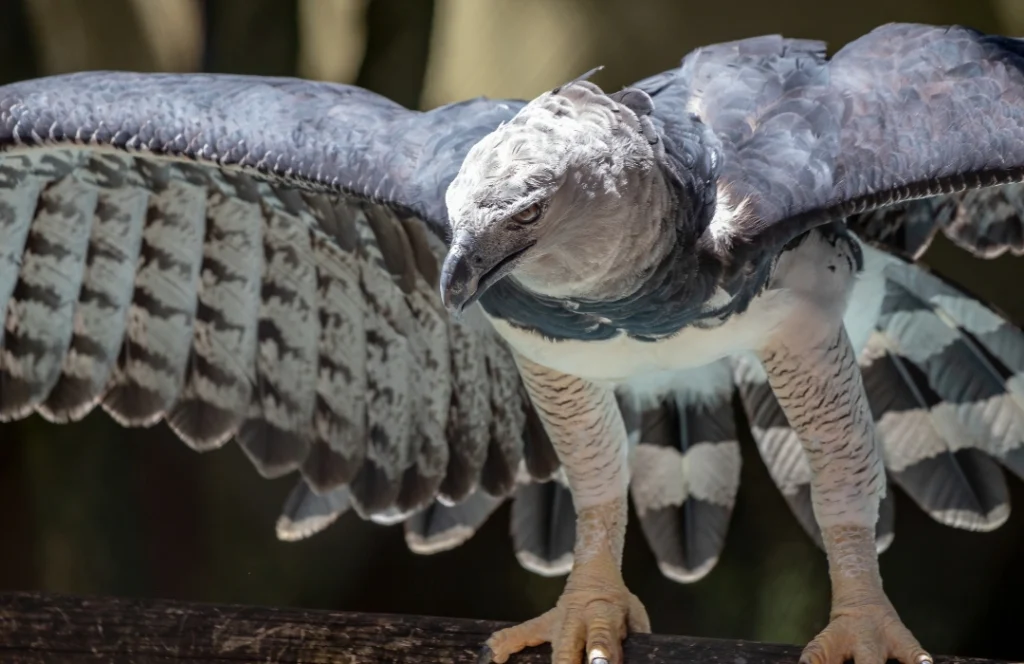
The Harpy Eagle (Harpia harpyja) is one of the world’s most powerful eagles, known for its massive size, strong talons, and striking feathered crest. Found in the tropical rainforests of Central and South America, this eagle is a top predator with the strength to hunt animals as large as monkeys and sloths. With its piercing gaze, black-and-white plumage, and signature crown of feathers, the Harpy Eagle is as visually captivating as it is formidable.
Known for: Unmatched Power and Strong Grip
The Harpy Eagle is renowned for its hunting capabilities, using its muscular legs and powerful talons to catch and carry prey that often weighs as much as itself. Despite its large size, it is agile in the dense forest canopy, expertly handling between branches to capture its target. Its talons, among the largest in the eagle family, can exert more force than a Rottweiler’s bite, allowing it to secure even the most challenging prey.
One Rarely Known Fact: The Harpy Eagle’s talons are so large that they can grow up to 5 inches, making them the longest talons of any eagle.
Quick Info:
- Scientific Name: Harpia harpyja
- Average Wingspan: 6.5 to 7.5 feet (2 to 2.3 meters)
- Weight: 13 to 20 pounds (6 to 9 kilograms)
- Diet: Primarily sloths, monkeys, birds, and other small to medium-sized mammals
- Life Span: Up to 35 years in the wild
- Habitat: Tropical rainforests of Central and South America, including the Amazon Basin
Conservation Status:
The Harpy Eagle is classified as Near Threatened. Deforestation poses a severe threat to its habitat, and with its slow breeding cycle, population recovery is challenging. Conservation programs are focused on preserving its rainforest environment and educating local communities about the ecological role of this apex predator.
2. Bald Eagle
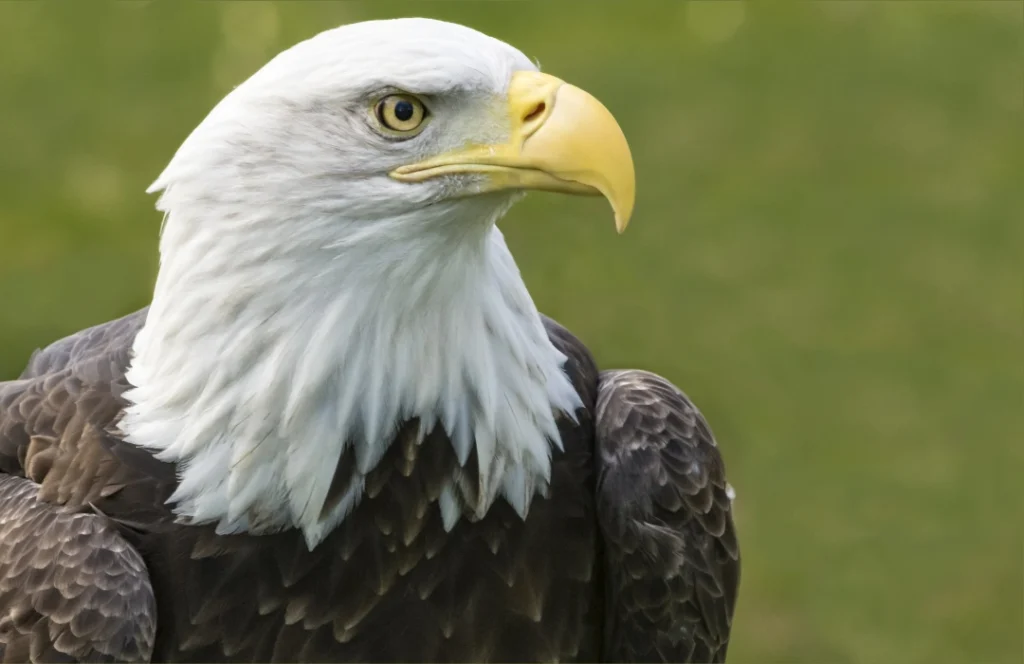
The Bald Eagle (Haliaeetus leucocephalus), with its distinctive white head and dark brown body, is the national bird of the United States and a symbol of freedom. This eagle is commonly found across North America, especially near large bodies of water where it has access to fish, its primary food source. Known for its impressive wingspan and powerful flight, the Bald Eagle is one of the continent’s most admired and widely recognized birds.
Known for: Resilience and Symbolic Importance
The Bald Eagle’s strong conservation comeback story is a remarkable success. In the mid-20th century, its population dwindled due to pesticide use and habitat loss, but thanks to conservation efforts, the Bald Eagle has recovered impressively. This raptor hunts fish by diving down at high speeds, clutching its prey with sharp talons before soaring away, making it a captivating sight over lakes and rivers.
One Rarely Known Fact: Despite its majestic appearance, the Bald Eagle often steals food from other birds, particularly ospreys, instead of catching its own.
- Scientific Name: Haliaeetus leucocephalus
- Average Wingspan: 6 to 8 feet (1.8 to 2.4 meters)
- Weight: 6.5 to 14 pounds (3 to 6.5 kilograms)
- Diet: Primarily fish, but also small mammals, birds, and carrion
- Life Span: 20 to 30 years in the wild
- Habitat: Near large bodies of water across North America, including lakes, rivers, and coastal regions
Conservation Status:
Once listed as Endangered, the Bald Eagle is now classified as Least Concern due to significant conservation efforts. The banning of harmful pesticides, legal protection, and habitat preservation have helped restore its numbers, marking a successful conservation story
3. Philippine Eagle: National Bird of Philippine, Majestic and Most Endangered
The Philippine Eagle (Pithecophaga jefferyi), also known as the “Monkey-Eating Eagle,” is one of the world’s rarest and largest eagles. Endemic to the Philippines, this eagle is revered for its size, beauty, and strength, with a unique, shaggy crest and intense, piercing eyes. As a top predator in the rainforest ecosystem, the Philippine Eagle primarily hunts monkeys and other small mammals, solidifying its status as a critical part of its natural habitat.
Known for: Exceptional Rarity and National Symbol
The Philippine Eagle is both a national symbol and a conservation priority in the Philippines. Known for its sharp eyesight and powerful talons, it can detect prey from afar and catch it with precision. This eagle is particularly dependent on undisturbed forests, making deforestation a major threat. Due to its restricted range and habitat, the Philippine Eagle is among the most endangered raptors globally.
One Rarely Known Fact: The Philippine Eagle can grow up to 3.3 feet (1 meter) tall, making it one of the tallest eagles in the world.
Quick Info:
- Scientific Name: Pithecophaga jefferyi
- Average Wingspan: Up to 7.2 feet (2.2 meters)
- Weight: 10 to 18 pounds (4.5 to 8 kilograms)
- Diet: Monkeys, birds, flying lemurs, and small mammals
- Life Span: Up to 40 years in captivity
- Habitat: Dense tropical rainforests in the Philippines, primarily on the islands of Luzon, Leyte, and Mindanao
Conservation Status:
The Philippine Eagle is critically endangered, with only a few hundred individuals remaining in the wild. Ongoing deforestation, hunting, and loss of habitat continue to threaten its survival. Conservation initiatives include captive breeding, reforestation efforts, and education programs aimed at protecting this unique species.
Golden Eagle: The Powerful and Adaptable Raptor of the Northern Hemisphere
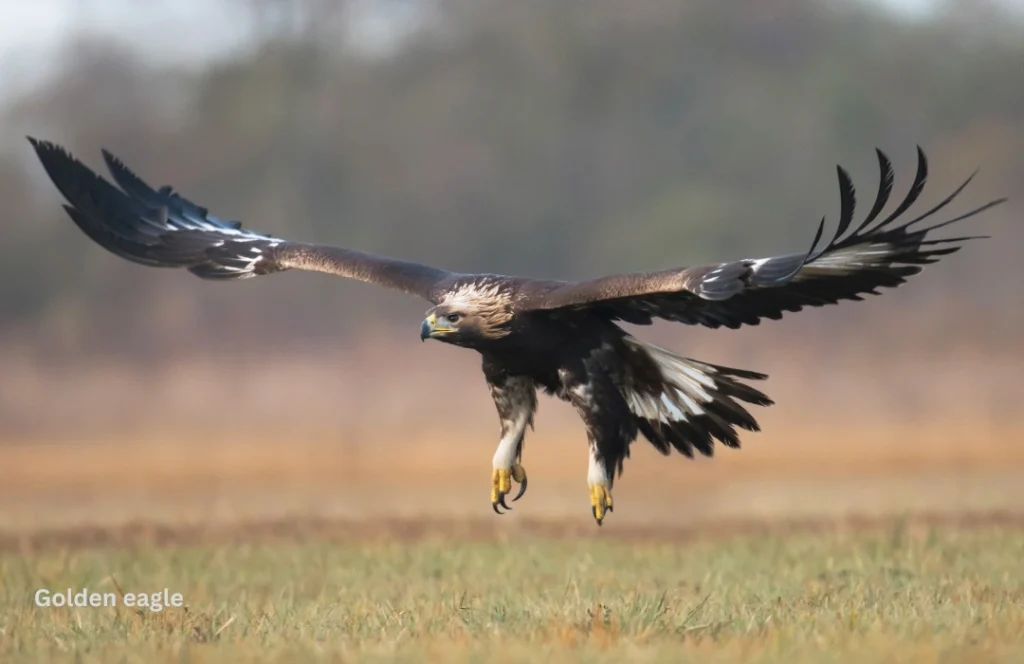
The Golden Eagle (Aquila chrysaetos) is one of the most widely distributed and adaptable eagle species, found across the Northern Hemisphere. Known for its golden-brown plumage and powerful build, this eagle is revered in many cultures and is a symbol of strength and courage. The Golden Eagle’s sharp talons, strong beak, and keen eyesight make it an exceptional hunter capable of tackling prey as large as young deer.
Known for: Versatility and Strength
Golden Eagles are highly adaptable, thriving in habitats ranging from arid deserts to mountainous regions. Their hunting strategies vary based on their environment; they can swoop down at speeds exceeding 150 mph to catch prey. These eagles are monogamous and often form long-term pair bonds, with both partners cooperating in hunting and defending their territory.
One Rarely Known Fact: Golden Eagles are capable of stunning flights, using thermal updrafts to soar for hours without flapping their wings.
Quick Info:
- Scientific Name: Aquila chrysaetos
- Average Wingspan: 6 to 7.5 feet (1.8 to 2.3 meters)
- Weight: 6 to 15 pounds (3 to 6.8 kilograms)
- Diet: Primarily rabbits, hares, ground squirrels, but also foxes, birds, and carrion
- Life Span: 15 to 30 years in the wild
- Habitat: Mountains, plains, and deserts across North America, Europe, and parts of Asia
Conservation Status:
The Golden Eagle is classified as Least Concern; however, habitat destruction, illegal hunting, and accidental poisoning pose ongoing threats in certain areas. Conservation efforts focus on preserving open landscapes, monitoring populations, and reducing human impact in their habitats.
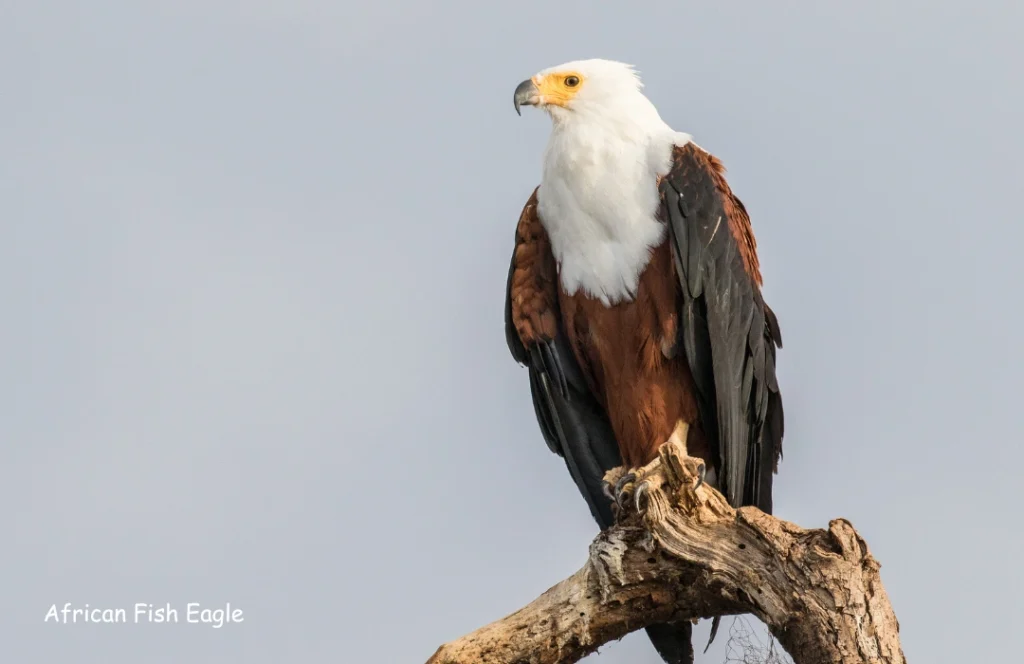
5. African Fish Eagle: The Voice of Africa’s Waterways
The African Fish Eagle (Haliaeetus vocifer), with its distinctive black, white, and brown plumage, is one of Africa’s most iconic birds, often seen perched high above lakes, rivers, and wetlands. Known for its unmistakable call—a sound that has become synonymous with African wilderness—the African Fish Eagle is an expert hunter and skilled flyer, capable of swooping down to snatch fish from the water with remarkable accuracy. This majestic bird of prey is widespread across sub-Saharan Africa and is closely associated with the continent’s waterways.
Known for: Precision Fishing Skills and Iconic Call
The African Fish Eagle is a master fisherman, relying heavily on fish but also preying on smaller water birds, amphibians, and even reptiles when necessary. With talons adapted to grasp slippery fish and eyesight sharp enough to spot movement in the water from great heights, it swoops down with rapid precision, often clutching its catch without even pausing. This eagle’s resonant, piercing call can be heard echoing over water bodies, and its presence is cherished by bird watchers, wildlife enthusiasts, and locals alike.
One Rarely Known Fact: The African Fish Eagle has rough, spiny pads on its talons, which help it grip slippery fish—making it an effective fisher even in challenging conditions.
Quick Info:
- Scientific Name: Haliaeetus vocifer
- Average Wingspan: 6 to 8 feet (1.8 to 2.4 meters)
- Weight: 4.4 to 7.9 pounds (2 to 3.6 kilograms)
- Diet: Primarily fish, with occasional water birds, amphibians, and reptiles
- Life Span: 12 to 24 years in the wild
- Habitat: Lakes, rivers, and wetlands across sub-Saharan Africa, often near large bodies of fresh water
Conservation Status:
The African Fish Eagle is currently classified as Least Concern, benefiting from its adaptability and wide distribution across Africa. However, environmental threats, such as water pollution and overfishing, could impact its food sources in the future. Conservation efforts are focused on preserving wetland ecosystems, which are crucial not only for the African Fish Eagle but for a diverse array of wildlife.
5. Bateleur Eagle: The Acrobat of the African Skies
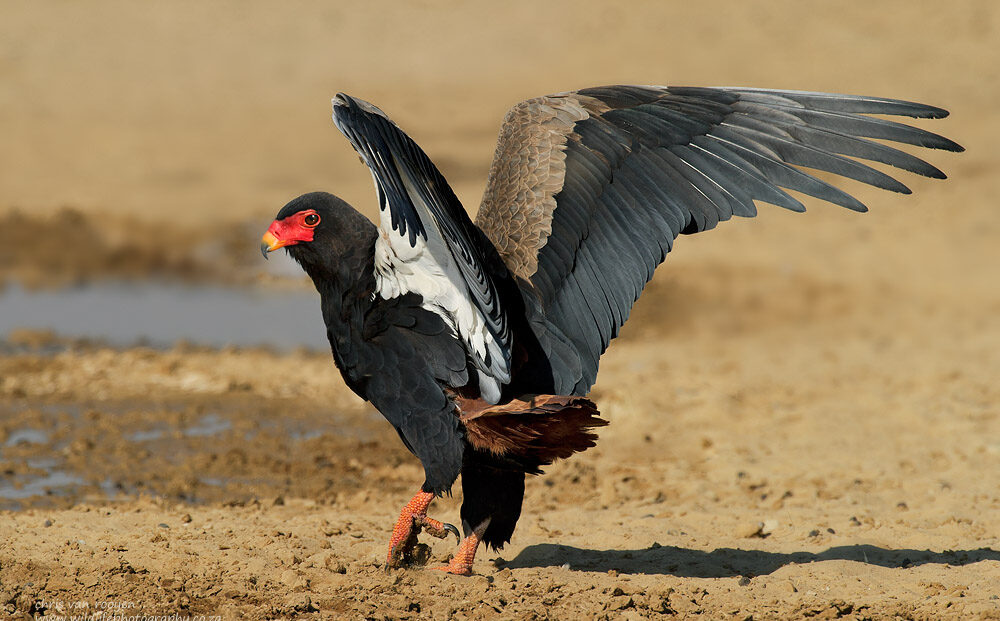
The Bateleur Eagle (Terathopius ecaudatus) is a spectacular bird of prey found throughout the savannas and woodlands of sub-Saharan Africa. This eagle is unmistakable in flight with its short tail, bold black-and-white plumage, and bright red face and legs. The Bateleur is known for its aerial acrobatics, displaying a unique, rocking flight pattern that makes it appear like dancing in the sky—hence its name, which means “street performer” or “juggler” in French.
The Bateleur’s bold colours and short tail make it visually unique among eagles. Unlike other raptors, its wings are much longer than its tail, requiring a particular flying style for balance. This eagle spends much of its time gliding gracefully in wide circles, often covering large distances while looking for prey or carrion.
The Bateleur Eagle can go up to 8 days without water, a remarkable adaptation that allows it to thrive in arid African landscapes.
Average Wingspan: Approximately 6 feet (1.8 meters)
Scientific Name: Terathopius ecaudatus
Weight: 4 to 6.5 pounds (1.8 to 3 kilograms)
Diet: Small mammals, reptiles, other birds, and carrion
Life Span: Up to 25 years in the wild
Habitat: Open savannas, woodlands, and semi-desert areas in sub-Saharan Africa
Conservation Status:
The Bateleur Eagle is currently listed as Near Threatened due to habitat loss, poisoning, and hunting. Conservation efforts are focused on protecting its habitat and reducing human-related threats, as this eagle is essential to the ecosystem as a scavenger and predator.
6. Steller’s Sea Eagle

Steller’s Sea Eagle is one of the largest and most p
Steller’s Sea Eagle: The Powerful Raptor of the North Pacific
The Steller’s Sea Eagle (Haliaeetus pelagicus) is one of the world’s largest and heaviest eagles, known for its striking black-and-white plumage and massive, vibrant yellow beak. Native to the coastal regions of Northeast Asia, particularly around the Sea of Okhotsk and the Kamchatka Peninsula, this formidable raptor is closely tied to its icy coastal habitats, where it primarily hunts fish. The Steller’s Sea Eagle is revered both for its size and for its significance in many cultures around the North Pacific.
Known for: Majestic Appearance and Strength
With a wingspan that can reach over 8 feet, the Steller’s Sea Eagle has an impressive presence as it glides gracefully over coastal waters. Its hunting prowess is equally remarkable, with sharp eyesight and powerful talons adapted for catching fish. The eagle is known to eat salmon and trout, often seen perched on icy shorelines or flying low over the sea in search of its next meal. During winter, it migrates southward in search of open water, where it can continue its hunting.
One Rarely Known Fact: The Steller’s Sea Eagle has the largest and most powerful beak of any eagle species, allowing it to handle the toughest of prey with ease.
Quick Info:
- Scientific Name: Haliaeetus pelagicus
- Average Wingspan: 6.5 to 8.2 feet (2 to 2.5 meters)
- Weight: 11 to 20 pounds (5 to 9 kilograms)
- Diet: Primarily fish, especially salmon, trout, and other large freshwater fish, occasionally small mammals and birds
- Life Span: 20 to 25 years in the wild
- Habitat: Coastal cliffs, rivers, and lakes of Northeast Asia, particularly in Russia and Japan
Conservation Status:
The Steller’s Sea Eagle is listed as Vulnerable. Habitat loss, pollution, and reduced fish stocks threaten its population. Conservation efforts focus on habitat protection, pollution reduction, and raising awareness to protect this rare and majestic eagle across its range.
6. Martial Eagle: Largest and Most Formidable Eagle

The Martial Eagle (Polemaetus bellicosus) is a giant of the African skies, widely recognized as the continent’s largest eagle. This majestic raptor is known for its imposing size, with powerful talons and keen eyesight that allow it to hunt a wide variety of prey, from small mammals to other large birds. Found throughout sub-Saharan Africa, the Martial Eagle’s distinctive dark brown and white plumage, intense eyes, and broad wings make it one of the most remarkable birds of prey.
Known for: Exceptional Strength and Power
The Martial Eagle’s prowess as a hunter is unmatched among African eagles. Its size and strength enable it to capture and carry prey as large as small antelope, making it one of the top avian predators. This eagle is highly adaptive, utilizing both open savannas and woodlands to hunt a range of animals, including monkeys, monitor lizards, and even jackals. With a wingspan that stretches up to eight feet, the Martial Eagle is capable of covering vast territories in search of food and is rarely seen perched for long.
Martial Eagles can spot prey from nearly three miles away thanks to their extraordinary vision, which is nearly three times sharper than human eyesight.
Quick Info:
Scientific Name: Polemaetus bellicosus
Average Wingspan: Up to 8.5 feet (2.6 meters)
Weight: 8 to 14 pounds (3.5 to 6.5 kilograms)
Diet: Monkeys, small antelope, reptiles, large birds, and jackals
Life Span: 12 to 14 years in the wild; longer in captivity
Habitat: Open savannas, grasslands, and woodlands across sub-Saharan Africa
Conservation Status:
The Martial Eagle is classified as Vulnerable due to habitat loss, hunting, and accidental poisoning. As human encroachment and agricultural development expand, the eagle’s natural habitat and prey base are threatened. Conservation programs focus on habitat protection, educating communities on the ecological importance of this apex predator, and minimizing human-wildlife conflict to secure its survival.
The Martial Eagle’s incredible size, power, and unique role as a top predator make it one of Africa’s most fascinating raptors.
7. African Crowned Eagle: The Apex Predator of Africa’s Forests

The African Crowned Eagle (Stephanoaetus coronatus), also known as the “leopard of the skies,” is one of the most powerful and awe-inspiring birds of prey in Africa. Found mainly in dense forests and woodlands, this eagle is known for its unique hunting prowess, strength, and striking crest of feathers atop its head, giving it a regal appearance. With piercing yellow eyes and a wingspan that allows it to navigate through dense forest canopies, the African Crowned Eagle is a true master of its environment.
Known for: Powerful Talons and Fearless Hunting Abilities
The African Crowned Eagle’s strength is legendary. Its powerful talons can exert more force than those of any other eagle species, allowing it to hunt larger prey, including monkeys and small antelope. This eagle is both fearless and incredibly agile, known for its silent ambushes from dense foliage. With its striking plumage and fierce hunting reputation, the African Crowned Eagle has earned a mythical status among wildlife enthusiasts and locals alike.
One Rarely Known Fact: African Crowned Eagles have been recorded to hunt prey as heavy as their own body weight, making them one of the strongest eagles in terms of lifting power.
Quick Info:
- Scientific Name: Stephanoaetus coronatus
- Average Wingspan: 5 to 6 feet (1.5 to 1.8 meters)
- Weight: 6.5 to 10 pounds (3 to 4.5 kilograms)
- Diet: Monkeys, small antelope, reptiles, and large birds
- Life Span: Up to 14 years in the wild, longer in captivity
- Habitat: Dense forests, riverine woodlands, and savannas across sub-Saharan Africa
Conservation Status:
The African Crowned Eagle is classified as Near Threatened. Due to deforestation and human encroachment, its habitats are increasingly fragmented, leading to a decline in populations. Conservation efforts focus on protecting forest habitats and raising awareness about the species’ ecological importance as a top predator.
8. Crowned Hawk Eagle: The Stealthy Hunter of Africa’s Jungles
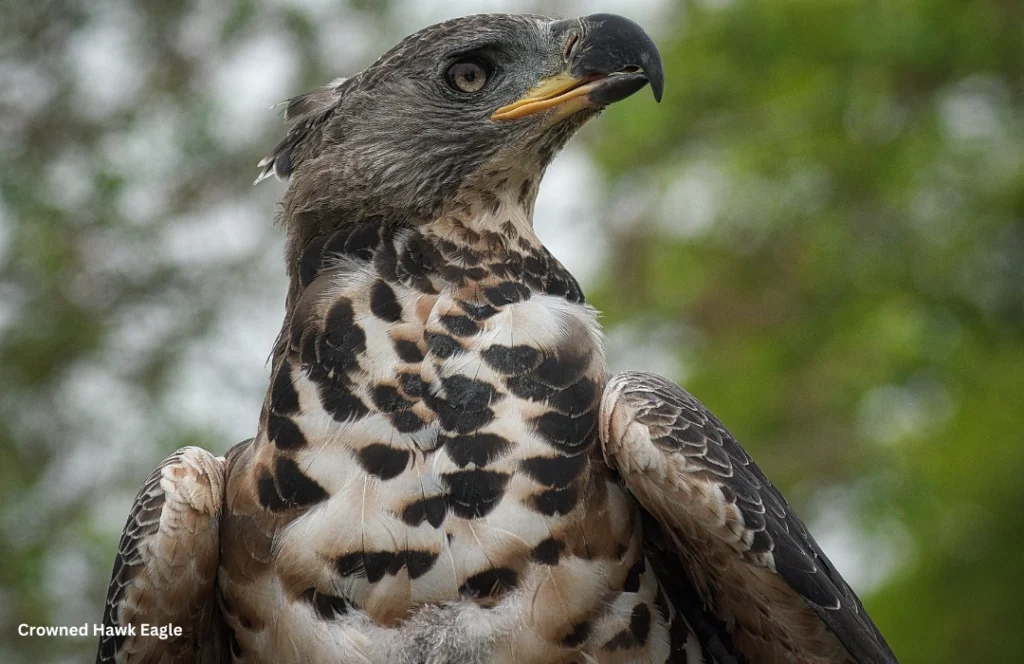
The Crowned Hawk Eagle (Stephanoaetus coronatus), commonly known as the African Crowned Eagle, is one of Africa’s most formidable and stealthy birds of prey. Found in the thick, shaded forests of sub-Saharan Africa, this eagle is known for its immense strength, agility, and impressive crown of feathers, which gives it a noble, almost mythical appearance. Often described as the “leopard of the air,” the Crowned Hawk Eagle is a powerful predator capable of taking down animals much larger than itself, making it one of the most skilled hunters in the avian world.
Known for: Strength and Stealth in Dense Forests
This eagle is uniquely adapted for life in dense woodlands and tropical forests. Its short wings and long tail provide the agility needed to navigate thick tree canopies, allowing it to surprise its prey with swift, silent ambushes. The Crowned Hawk Eagle is also one of the few birds capable of hunting primates, such as monkeys, and small antelope, showcasing both its strength and hunting prowess. Its powerful talons are known to exert incredible force, securing it as one of the most impressive raptors on the planet.
The Crowned Hawk Eagle’s talons can exert a grip of over 1,100 pounds per square inch (psi)—a force strong enough to crush bones, allowing it to tackle even sizable prey.
Quick Info:
Scientific Name: Stephanoaetus coronatus
- Average Wingspan: 5 to 6 feet (1.5 to 1.8 meters)
- Weight: 6.5 to 10 pounds (3 to 4.5 kilograms)
- Diet: Monkeys, small antelope, large birds, and reptiles
- Life Span: Up to 14 years in the wild, with some individuals living longer in captivity
- Habitat: Dense tropical forests and riverine woodlands in sub-Saharan Africa
Conservation Status:
The Crowned Hawk Eagle is classified as Near Threatened. Habitat loss due to deforestation and human encroachment poses significant risks to its populations. Conservation efforts are crucial to preserve its forested habitats, ensuring this apex predator remains a critical part of the ecosystem.
9. White-Bellied Sea Eagle: The Coastal Hunter of the Skies
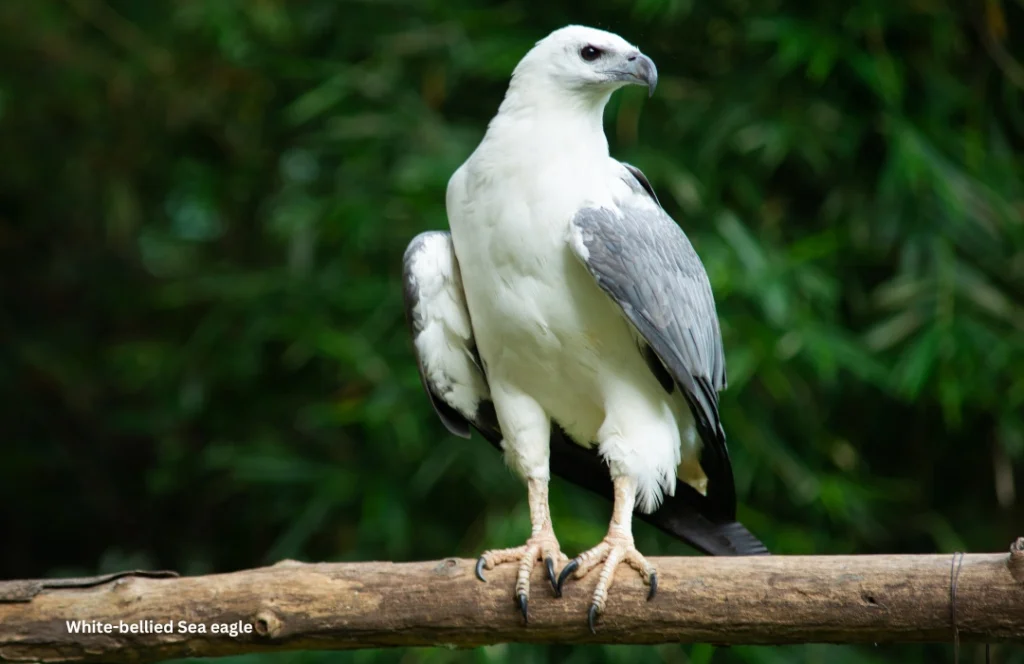
The White-Bellied Sea Eagle (Haliaeetus leucogaster) is a magnificent bird of prey, primarily found along coastal areas, rivers, and large inland lakes across South and Southeast Asia, Australia, and parts of Oceania. With its striking white head, chest, and belly contrasted by gray wings and a powerful, hooked beak, this eagle is a skilled hunter and a distinctive figure in the skies above the waters it calls home.
Known for: Exceptional Hunting Skills and Coastal Habitat
White-bellied sea Eagles are superbly adapted to life in the water. With keen eyesight and sharp claws, they dive down to snatch fish from the surface, rarely missing a target. Beyond their fishing prowess, they also hunt other birds, reptiles, and small mammals, displaying remarkable versatility in their diet. The eagle’s haunting, high-pitched call is a familiar sound along coastlines and waterways, often heard before the eagle itself is seen gliding above.
One Rarely Known Fact: White-bellied sea Eagles have a unique courtship ritual in which they lock talons in mid-air, twisting towards the ground before separating just before impact—an acrobatic display of bond and strength.
Quick Info:
- Scientific Name: Haliaeetus leucogaster
- Average Wingspan: Up to 7.2 feet (2.2 meters)
- Weight: 4 to 9 pounds (1.8 to 4 kilograms)
- Diet: Fish, water birds, small mammals, and reptiles
- Life Span: Up to 30 years in the wild
- Habitat: Coastal regions, rivers, and large inland bodies of water across Southeast Asia, Australia, and parts of Oceania
Conservation Status:
The White-Bellied Sea Eagle is classified as Least Concern, but its numbers are threatened by habitat destruction, pollution, and human disturbance. Conservation efforts focus on protecting their nesting sites and maintaining clean, fish-rich waterways, vital for their survival.
Each eagle represents raptors’ power, beauty, and diversity worldwide. From the dense forests of the Philippines to the open savannas of Africa, these magnificent birds continue to inspire wonder and respect. By learning more about these eagles and supporting conservation efforts, we can help ensure that future generations can witness their grandeur in the wild.
Frequently Asked Questions
1. What makes an eagle beautiful?
Eagles are admired for their impressive size, striking plumage, powerful beaks, and sharp talons. Each species has unique features like feather colors, eye color, and wingspan that contribute to their beauty. Some eagles also have graceful flying techniques and distinctive hunting styles, which add to their appeal.
2. Which eagle is considered the largest in the world?
The Harpy Eagle and the Steller’s Sea Eagle are often regarded as two of the largest eagles. Harpy Eagles have incredible wingspans and talons, while Steller’s Sea Eagles are known for their heavy bodies and massive beaks.
3. Where can I see the Bald Eagle in the wild?
The Bald Eagle, native to North America, can be spotted near large bodies of water like rivers, lakes, and coastal regions. They are most commonly seen in Alaska, Canada, and the contiguous United States, especially in protected areas and national parks.
4. Why is the Philippine Eagle endangered?
The Philippine Eagle is critically endangered due to habitat loss, deforestation, and hunting. Efforts to save this majestic bird focus on habitat preservation, anti-poaching laws, and awareness campaigns to protect one of the rarest eagles in the world.
5. Are eagles loyal to their mates?
Yes, most eagle species are monogamous and form long-term pair bonds. They often return to the same nesting site each year with their mate, sharing responsibilities in raising their young.
6. What do eagles typically eat?
Eagles are primarily carnivorous and have a varied diet depending on the species. Many, like the Golden Eagle, hunt small mammals, while fish-eating species, such as the African Fish Eagle and Steller’s Sea Eagle, specialize in catching fish.
7. How long do eagles live?
In the wild, most eagles live between 15 to 30 years, though some species, like the Bald Eagle, may live even longer in captivity due to safer conditions and regular care.
8. Are there eagles that live in the rainforest?
Yes, the Harpy Eagle and the Philippine Eagle are both rainforest dwellers. These species have adapted to dense forest habitats and rely on the availability of prey like monkeys and other forest animals.
9. How do eagles help maintain the ecosystem?
Eagles are apex predators, helping to keep populations of prey species in balance. By controlling smaller animal populations, they contribute to the health and stability of their ecosystems. Fish-eating eagles, for example, play a key role in river and lake ecosystems.
10. Can eagles see in the dark?
Eagles have excellent vision during the day, far superior to human eyesight, but they are not equipped for night vision. They rely on their acute eyesight to spot prey from great distances in daylight, but they are not nocturnal hunters like owls.
11. Which eagle has the strongest talons?
The Harpy Eagle is known for having the strongest talons of any eagle, capable of exerting pressure that can crush the bones of its prey. This power allows the Harpy Eagle to hunt larger animals, including monkeys and sloths.
12. What is the national bird of the United States?
The Bald Eagle is the national bird and symbol of the United States. This majestic eagle was chosen for its strength, freedom, and resilience, representing the country’s ideals since 1782.
13. How far can eagles travel?
Eagles, especially migratory species, can travel vast distances. For example, Golden Eagles and Steller’s Sea Eagles have been known to migrate thousands of miles in search of food and suitable habitats.
14. Are eagles endangered?
Some eagle species, like the Philippine Eagle, are critically endangered due to habitat destruction and hunting. However, conservation efforts have helped certain species, such as the Bald Eagle, recover from the brink of extinction.
15. Which eagle is known for its impressive flight displays?
The Bateleur Eagle is famous for its graceful and acrobatic flight displays, often gliding and rocking through the sky with minimal wing movement, giving it a unique, almost theatrical presence in the African skies.


